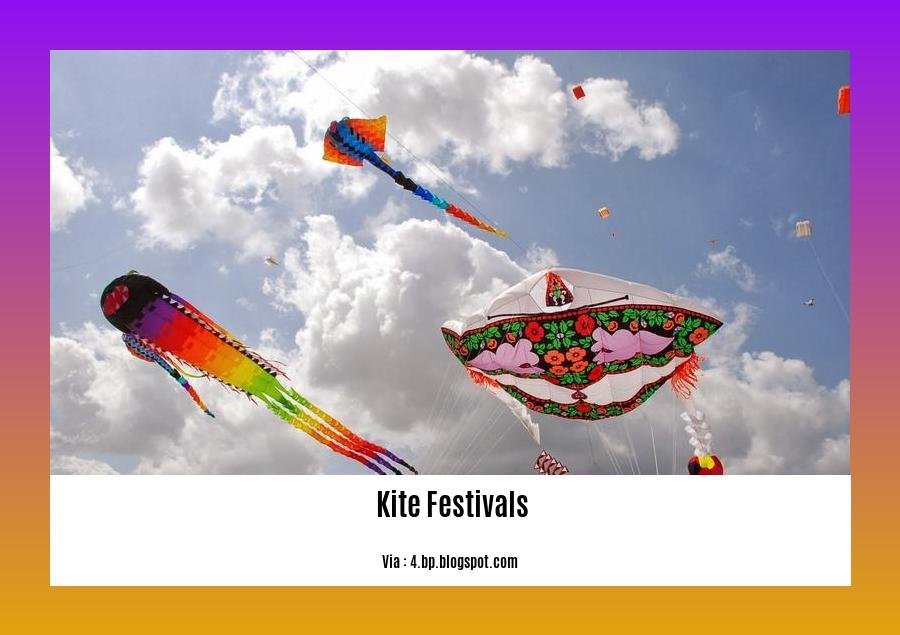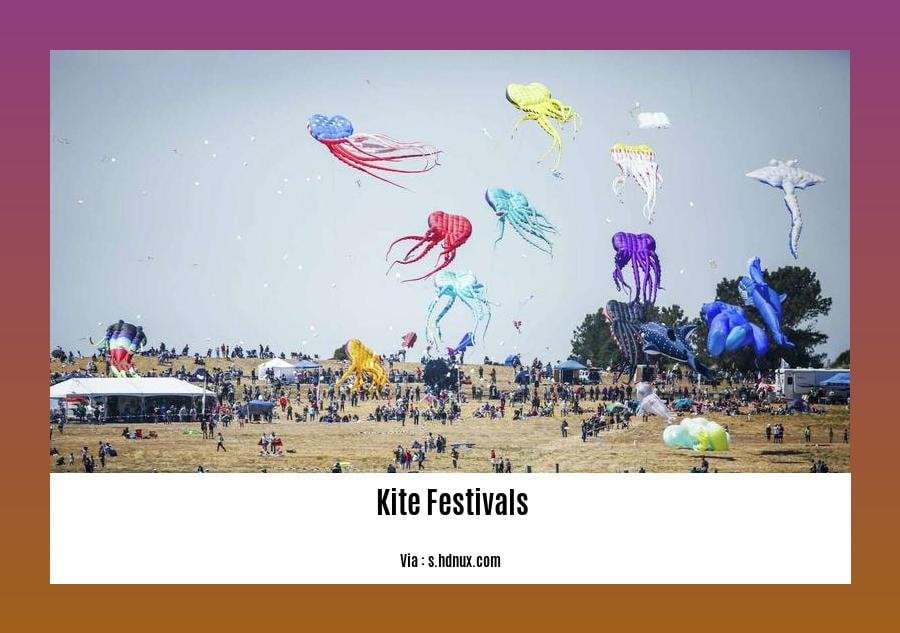Embark on a vibrant odyssey through the captivating world of kite festivals in our comprehensive guide, “A Kaleidoscope of Colors: A Guide to Captivating Kite Festivals Around the World.” Delve into the mesmerizing spectacle of kites soaring against the azure sky, and witness the cultural heritage and artistic ingenuity behind these captivating events. From the vibrant skies of India to the whimsical creations of Europe, let us guide you through an unforgettable journey.
Key Takeaways:
- Kite festivals celebrate cultural heritage in various parts of the world.
- Gujarat’s International Kite Festival showcases the immense popularity of kites in India, especially during Makar Sankranti.
- Bali Kite Festival attracts international participants with its unique kite designs.
- The International Dieppe Kite Festival in France exhibits diverse kite artistry from around the globe.
- Blossom Kite Festival in Washington, D.C. combines vibrant kites with cultural significance.
Kite Festivals: A Captivating Kaleidoscope of Colors

Kite flying isn’t just a hobby; it’s an art form that transcends time and borders, celebrated by festivals worldwide. From the vibrant skies of India to the breezy shores of Indonesia, these events showcase a breathtaking display of creativity and cultural heritage.
International Kite Festival, Gujarat, India
This iconic festival coincides with the auspicious Makar Sankranti celebration, attracting kite enthusiasts from every corner of the globe. As the sky transforms into a vibrant tapestry, kites of all shapes and sizes dance gracefully in the wind.
Bali Kite Festival, Indonesia
Renowned for its unique and intricate kites, the Bali Kite Festival is a spectacle of artistry. From traditional “Bebean” kites resembling mythological creatures to colossal kites soaring high above, the festival is a visual feast.
International Dieppe Kite Festival, France
At this prestigious event, witness a kaleidoscope of kites from every corner of the world. From whimsical creations to awe-inspiring masterpieces, the International Dieppe Kite Festival showcases the boundless imagination of kite builders.
Blossom Kite Festival, Washington, D.C., USA
This vibrant festival celebrates the Japanese tradition of “hanami” (cherry blossom viewing) with an array of colorful kites that flutter amidst the delicate pink blossoms. The event is a perfect blend of nature’s beauty and human creativity.
Benefits of Attending Kite Festivals
- Cultural immersion: Experience the vibrant traditions and artistry that surround kite festivals.
- Artistic appreciation: Witness the extraordinary craftsmanship and creativity of kite builders.
- Nostalgia and childhood memories: Relive the joy of flying kites, a timeless activity that stirs fond memories.
- Stress relief: The gentle sway of kites and the vibrant colors have a calming effect on the mind and spirit.
- Community building: Share the joy of kite flying with friends and family, creating a memorable and bonding experience.
You’ll be fascinated to know the history of kites and their journey through time and cultures. Uncover the ancient Chinese origins of kites and their significance in different civilizations.
Kite-Making Techniques and Materials

As a seasoned kite enthusiast, I’ve witnessed the intricate art of kite-making firsthand. From the selection of materials to the meticulous construction techniques, each step plays a crucial role in creating these awe-inspiring aerial wonders.
Materials
The choice of materials ensures the kite’s durability and flight performance.
- Bamboo sticks: These lightweight and sturdy sticks provide the kite’s framework.
- Washi paper: Thin and strong, this Japanese paper forms the lightweight and flexible body of the kite.
- Silk or cotton threads: Delicate yet resilient, these threads connect the frame and body, ensuring strength and stability.
Techniques
Traditional and modern techniques merge to create stunning kites.
- Traditional methods: Handed down through generations, these techniques involve skilled craftsmanship and time-honored practices.
- Modern adaptations: Innovative materials and techniques enhance kite designs and flight performance while preserving tradition.
Historical Significance
Kite-making has a rich history, particularly in Japan, where it has been a beloved pastime for centuries. Traditional Japanese kites, such as Edo-style kites, are recognized for their intricate designs and vibrant colors.
Key Takeaways:
- Japanese kites showcase traditional techniques and materials, blending aesthetics with functionality.
- Kite-making involves a harmonious balance of craftsmanship, art, and aerodynamics.
- Materials like bamboo, washi paper, silk, and cotton contribute to the kite’s strength, lightness, and flight characteristics.
- Innovative techniques enhance kite designs while preserving the essence of tradition.
Sources:
– Classic Kites: The Beautiful Artistry of Japanese Kites
– The 4 Best Materials For A Kite
Competitive Kite Flying Events and Competitions
So, you’re ready to dive into the thrilling world of competitive kite flying? Here’s a quick guide to get you soaring:
Classes and Categories
Competitive Kite Flying Events and Competitions offer a diverse range of classes and categories to unleash your kite-flying prowess. From single-line kites to quad-line stunt kites, there’s a class for every skill level and style.
Judging Criteria
Judges scrutinize kites based on their:
- Flight stability and precision
- Maneuverability and responsiveness
- Design and aesthetics
- Innovation and uniqueness
Training and Preparation
Mastering the art of competitive kite flying requires dedication and practice. Seek guidance from experienced flyers, attend workshops, and immerse yourself in the technicalities of kite aerodynamics.
Key Takeaways:
- Competitive Kite Flying Events and Competitions showcase the precision, artistry, and innovation of kite flying.
- Different classes and categories cater to various skill levels and kite types.
- Judging criteria assess flight performance, design, and creativity.
- Training and preparation are crucial for success in competitive kite flying.
Relevant URL Sources:
- International Kite Festival, Gujarat, India
- Portsmouth International Kite Festival, UK
Environmental Impact and Sustainability of Kite Festivals
While kite festivals are a joyous celebration of creativity and culture, they also require careful consideration of their environmental impact and sustainability. Here are key points to ponder:
Materials Matter: Kite festivals often use synthetic materials like nylon and polyester, which take hundreds of years to decompose. Encouraging the use of biodegradable materials like bamboo, paper, and natural fibers can reduce ecological harm.
Littering: Kite festivals generate a lot of trash, including kite fragments, strings, and packaging. Implementing proper waste management systems, such as designated trash bins and recycling points, helps prevent litter from polluting land and water bodies.
Sustainability Initiatives: Many kite festivals are adopting sustainable practices. These include:
– Using renewable energy sources like solar panels to power event infrastructure.
– Partnering with local environmental organizations to promote awareness and cleanup efforts.
– Offering incentives to attendees who bring their own reusable containers and reduce single-use plastics.
Key Takeaways:
- Synthetic materials and littering can negatively impact the environment.
- Biodegradable and reusable materials promote sustainability.
- Waste management systems and sustainability initiatives reduce ecological harm.
Relevant URL Sources:
- Sustainable Kite Festivals: Flying High with Environmental Responsibility
- Kite Festivals: A Guide to Environmental Sustainability
FAQ
Q1: What are the most popular destinations for kite enthusiasts to witness kite festivals?
A1: Kite festivals are renowned worldwide, with notable events in Gujarat, India; Bali, Indonesia; Dieppe, France; and Washington, D.C., USA.
Q2: What sets the International Kite Festival in Gujarat apart from others?
A2: Held annually on January 14th during Makar Sankranti, the International Kite Festival in Gujarat attracts millions of participants and showcases a vibrant array of traditional and contemporary kites.
Q3: What distinguishes Balinese kite designs from those of other festivals?
A3: The Bali Kite Festival in Indonesia captivates with its unique and intricate kite designs, such as the “bebean” (dragon) and “janggan” (barong), which reflect the island’s rich cultural heritage.
Q4: How have modern materials and techniques impacted the evolution of kite-making?
A4: While traditional techniques are still employed in Japanese kite-making, modern materials like carbon fiber and ripstop nylon have enhanced the performance and durability of kites.
Q5: What is the cultural significance of kite-flying in Japan?
A5: Kite-flying holds a deep traditional significance in Japan, with various festivals showcasing exquisite Edo-style kites known for their intricate designs and vibrant colors.
- Mastering Leader in Spanish: The Complete Guide - April 19, 2025
- Uncovering Surprising Parallels: England Size Compared to US States - April 19, 2025
- Old Mexico Map: Border Shifts 1821-1857 - April 19, 2025
















